Table of Contents
Table of Contents
If you've ever found yourself stuck in the midst of network connectivity issues, you know just how frustrating and isolating it can feel. But fear not! Today, we're embarking on a great network escape, where we'll explore the troubleshooting tips and tricks you need to break free from the clutches of network connectivity problems.
So buckle up, grab your favourite caffeinated beverage, and let's get ready to navigate the twists and turns of the network maze together. Whether you're a seasoned network guru or a newbie just dipping your toes into the world of connectivity, this guide is here to help you emerge victorious and fully connected. Let's dive in!
First, let's go over what's actually being affected.
Network connectivity refers to the capability of devices, systems, or networks to establish a connection and communicate with each other. It allows data, information, and resources to be shared between different devices or entities, typically over a wired or wireless infrastructure.
Network connectivity can be established using various technologies and protocols, including:
- Local Area Networks (LANs): LANs connect devices within a limited geographic area, such as a home, office, or campus. Ethernet and Wi-Fi are common technologies used for LAN performance.
- Wide Area Networks (WANs): WANs connect devices over larger geographical distances, often using the internet or private networks. The Internet itself is the largest WAN, but companies may also establish private WANs to connect their offices in different locations.
- Cellular Networks: Cellular networks provide wireless connectivity for mobile devices, such as smartphones and tablets, using technologies like 3G, 4G, and 5G.
- Satellite Networks: Satellite networks use orbiting satellites to enable connectivity in remote or areas with poor terrestrial infrastructure.
- Bluetooth and NFC: These short-range wireless technologies are used for connecting devices like smartphones, speakers, and wearables.
- Internet of Things (IoT) Connectivity: IoT devices connect to the internet or other networks to transmit data. They may use technologies like Wi-Fi, cellular, or low-power wide-area networks (LPWAN).
- Cloud Connectivity: Many devices and applications rely on connectivity to cloud services to store and access data, run applications, and provide remote access and control.
- Virtual Private Networks (VPNs): VPNs provide secure connectivity over public networks, allowing remote users to access private networks securely.
- Peer-to-Peer (P2P) Networks: In P2P networks, devices connect directly to each other without the need for a centralized server. This is often used for file sharing or communication applications.
- Ethernet and Fiber Optics: Wired technologies like Ethernet and fiber optics offer high-speed, reliable connectivity for devices within a LAN or data center.
- Wireless Mesh Networks: These networks consist of interconnected wireless nodes that work together to provide network coverage. They are often used in scenarios where traditional infrastructure is lacking.
Ensuring network connectivity involves configuring devices, setting up networking hardware (routers, switches, access points, etc.), and managing network protocols and security measures. Reliable network connectivity is essential for accessing the internet, sharing resources, transferring data, and enabling communication between devices in our increasingly interconnected world.
Network connectivity issues refer to problems or disruptions in establishing, maintaining, or accessing a network connection between two or more devices. Network connectivity issues can manifest in various ways, such as slow or intermittent internet speeds, inability to connect to a specific website or server, dropped connections, or complete loss of connectivity.
These issues can arise due to a variety of reasons, including hardware failures, software conflicts, network configuration problems, router or modem issues, network brownouts or Internet brownouts, and signal interference, among others.


Oh boy, network connectivity issues are like the ultimate party poopers! They can seriously rain on your parade, slowing down your internet speeds, causing dropped connections, and just generally making you want to scream into a pillow. And let's remember the impact they can have in a business setting, where lost productivity and revenue can add up quickly.
But fear not, my internet-loving friends! If you're armed with the right knowledge and troubleshooting tips, you can tackle those pesky connectivity problems head-on and reclaim your network. From slow speeds to dropped connections and beyond, we'll explore how network connectivity issues can wreak havoc on your network performance and productivity.
So let's get ready to break free from the shackles of network connectivity issues and dance our way to a happy, healthy, and connected network!
When it comes to businesses, network connectivity issues in a business setting can be a real downer. They can bring work to a grinding halt, causing employees to pull their hair out in frustration and potentially lose the business some serious cash. When network connectivity is disrupted, employees may be unable to access critical applications or collaborate with team members, leading to lost productivity and missed deadlines.
- Can cause work to come to a halt
- This can lead to lost productivity and missed deadlines
- This may prevent employees from accessing critical applications or collaborating with team members
- Can damage the business's reputation and bottom line if customers are unable to complete transactions or access services
- Creates security vulnerabilities, making it easier for cybercriminals to exploit network weaknesses and gain unauthorized access to sensitive information
- Crucial for businesses to address network connectivity issues promptly to ensure secure, reliable, and uninterrupted network performance.
Slow speeds, dropped connections, and lost productivity are just some of the issues that can come with the territory of networking. And if you're working with an enterprise network as a network engineer or IT pro, these problems can be even more frustrating and potentially costly. But fear not, my tech-savvy friends! With the right knowledge and tools, you can tackle network connectivity issues head-on and ensure that your network is always secure, reliable, and ready to support your business needs.
Ah, the joys of networking! From slow speeds to dropped connections, there's always something fun and exciting to keep us on our toes. But fear not, my fellow network troubleshooters - with the right knowledge, we can tackle these pesky connectivity issues and get our networks back in tip-top shape. So, grab your toolkit and let's dive into some of the most common network connectivity issues out there!
Slow network speeds (also referred to as network slowness) are one of the most common network connectivity issues that users encounter. Slow speeds can make it frustratingly difficult to download files, stream videos, or even browse the web.
Here are some of the common causes of slow network speeds:
- Outdated hardware: Older routers and network cards may not be able to handle modern internet speeds. If your hardware is outdated, it may be time to upgrade to faster equipment.
- Network congestion: If too many devices are connected to the network, it can create network congestion and slow down network speeds. This is especially true if multiple devices are trying to access the internet at the same time.
- Distance from the router: The farther you are from the router, the weaker your signal will be. This can lead to slow speeds or even dropped connections.
- Bandwidth limitations: Your internet service provider (ISP) may have bandwidth limitations that can affect your network speed. If you're regularly hitting your monthly data cap, you may want to consider upgrading to a plan with higher bandwidth limits.
- Malware or viruses: Malware or viruses can infect your computer and cause it to consume network resources, slowing down your internet speeds.
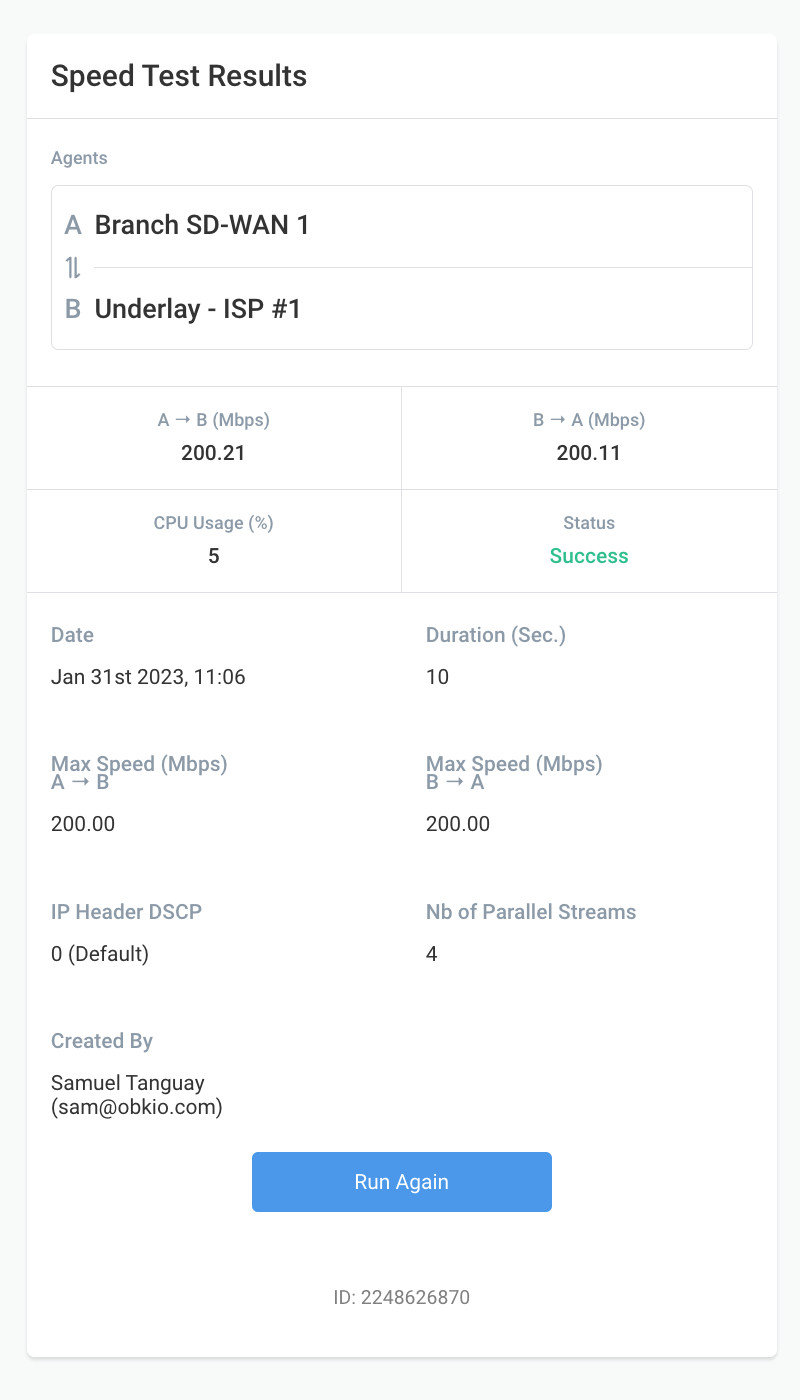
Dropped connections occur when a device loses its connection to the network, which can be frustrating and disruptive to your workflow.
Here are some of the common causes of dropped connections:
- Interference: Wireless networks can be affected by interference from other wireless devices or even physical objects, such as walls or appliances.
- Network congestion: Like slow speeds, network congestion can also cause dropped connections. If too many devices are competing for bandwidth on the network, it can cause devices to lose their connection.
- Distance from the router: The farther you are from the router, the weaker your signal will be. This can cause your device to lose its connection to the network.
- Outdated firmware: Outdated firmware on your router can cause dropped connections. Make sure your router is running the latest firmware to prevent this issue.
- Network security settings: Some security settings on your network may interfere with your device's ability to maintain a connection. For example, a too-restrictive firewall setting may block traffic and cause your device to lose its connection.
By identifying the root cause of dropped connections, you can take steps to address the issue and ensure that your devices stay connected to the network. This can help to improve your productivity and minimize disruptions to your workflow.
Are you tired of troubleshooting network issues alone? Take the hassle out of network monitoring and use Obkio to help you diagnose and fix connectivity problems.

- 14-day free trial of all premium features
- Deploy in just 10 minutes
- Monitor performance in all key network locations
- Measure real-time network metrics
- Identify and troubleshoot live network problems


Are you a network admin or IT pro looking to troubleshoot network connectivity issues for your business, or a personal user trying to troubleshoot from your remote office? Whether you need to troubleshoot large networks or single-user workstations, Obkio's Network Monitoring Tool has plans tailored for you. Find the right plan to help you identify and troubleshoot network connectivity issues with ease.
DNS resolution issues can cause problems with accessing websites, as well as slow down your network speeds. DNS (Domain Name System) is responsible for translating human-readable domain names such as www.google.com into IP addresses that can be understood by network devices.
Here are some common causes of DNS resolution issues:
- DNS server problems: If your DNS server is down or experiencing issues, it can prevent your devices from accessing websites.
- DNS cache problems: Your device may have outdated or incorrect information in its DNS cache, which can cause it to fail to resolve domain names.
- Router issues: Your router may have DNS settings that are misconfigured or out-of-date.
- Malware or viruses: Malware or viruses can interfere with your DNS settings and cause problems with DNS resolution.
- Network connectivity issues: Other network connectivity issues, such as slow speeds or dropped connections, can also cause DNS resolution issues.
By identifying the root cause of DNS resolution issues, you can take steps to address the issue and improve and optimize network performance. This may involve changing your DNS settings, updating your router's firmware, or using anti-malware software to scan for viruses or malware.
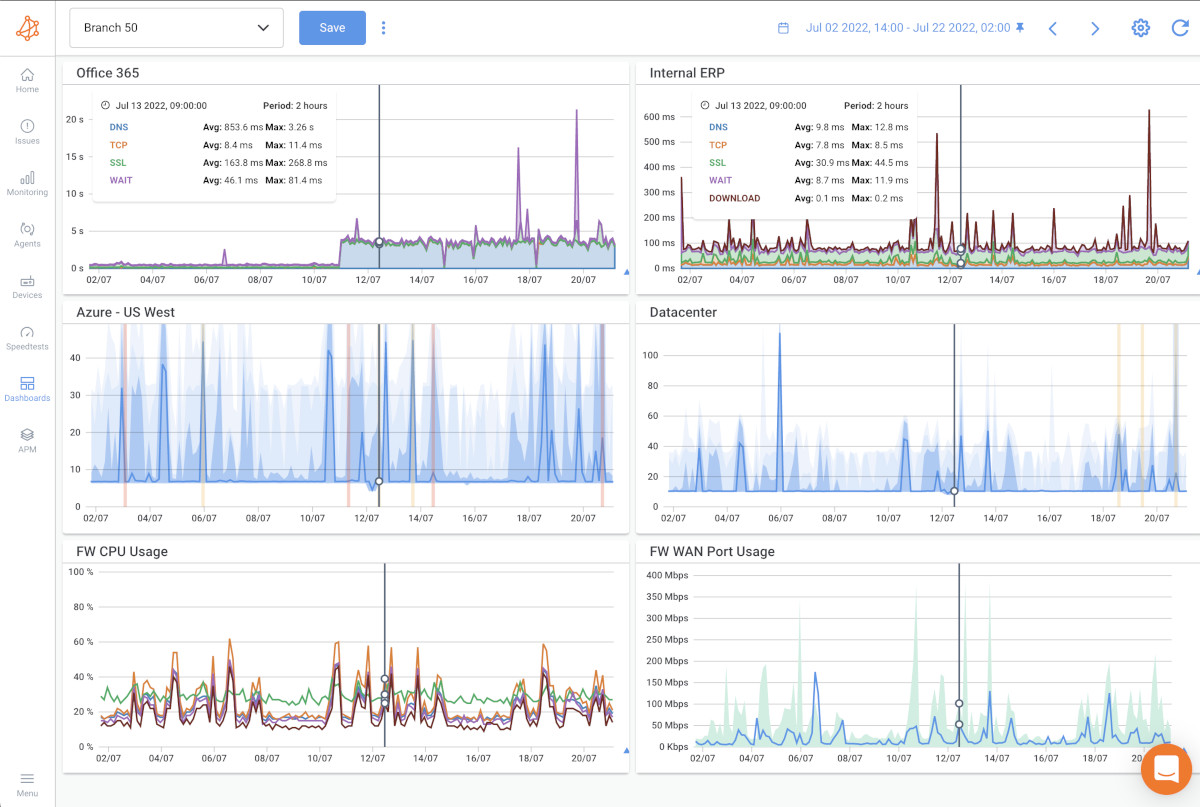
IP address conflicts occur when two or more devices on the same network are assigned the same IP address. This can cause network connectivity issues, such as devices being unable to communicate with each other or access the Internet.
Here are some common causes of IP address conflicts:
- DHCP server issues: DHCP (Dynamic Host Configuration Protocol) is responsible for assigning IP addresses to devices on the network. If there is a problem with the DHCP server, it may assign the same IP address to multiple devices.
- Static IP address configuration: If you manually assign a static IP address to a device, it may conflict with another device that has been assigned the same address.
- Guest networks: If you have a guest network set up on your network, it may be using the same IP address range as your primary network, causing conflicts.
- Rogue devices: A rogue device (such as a wireless access point or router) that has been added to the network may have a conflicting IP address.
- Network topology changes: If you add or remove devices from the network, it may cause IP address conflicts if the DHCP server is not properly configured.
By identifying the root cause of IP address conflicts, you can take steps to address the issue and improve your network performance. This may involve changing your DHCP server settings, assigning static IP addresses to specific devices, or using network monitoring tools to identify rogue devices on the network.
Firewalls are an essential component of network security, but they can also cause connectivity issues if they are misconfigured or overly restrictive.
Here are some common causes of firewall and security issues:
- Misconfigured firewall rules: If your firewall rules are misconfigured, they can block legitimate traffic and prevent devices from accessing the network.
- Firewall software conflicts: If you have multiple firewall software programs installed on a device, they may conflict with each other and cause connectivity issues.
- Antivirus software conflicts: Antivirus software can also cause firewall and security issues if it blocks legitimate network traffic.
- Outdated firmware: Outdated firewall firmware can cause security vulnerabilities and connectivity issues.
- Security policies: Overly restrictive security policies can prevent devices from accessing the network, which can cause connectivity issues.
By identifying the root cause of firewall and security issues, you can take steps to address the issue and improve your network performance. This may involve reviewing and updating firewall rules, uninstalling conflicting software, updating firmware, or adjusting security policies to allow for necessary network traffic. It is important to balance security with network accessibility to ensure that your network is both secure and functional.
Steps for Troubleshooting Network Connectivity Issues: How Would You Troubleshoot A Network Connectivity Problem?
Feeling stuck in a network slowdown nightmare? Fear not, for we have the escape plan you need. With some basic steps for troubleshooting network connectivity issues, you'll be well on your way to escaping the clutches of network slowness. Let's dive into the basics of troubleshooting network connectivity issues and find our way to freedom!
Before you can even begin to troubleshoot network connectivity issues, you need a tool to help you understand what the network connectivity issues are, what’s causing them, and when and where they happened.
The easiest way to troubleshoot network issues is by using Network Performance Monitoring and Troubleshooting like Obkio.
Obkio continuously monitors end-to-end network performance and network connectivity with synthetic traffic using Network Monitoring Agents. The Agents exchange synthetic traffic to measure network metrics, like packet loss, between each other, identify network issues, and collect the information to help you troubleshoot.

To actually identify network connectivity issues to troubleshoot, you need to deploy Network Monitoring Agents which continuously measure network performance in key network locations like offices, data centers and clouds. The Agents exchange synthetic traffic to measure network metrics between each other.
This will help you the root cause of the network connectivity issues and identify any network segments where the network issue is most pronounced. Essentially, to collect the data you need to translate, you’ll need:
- Local Agents: Installed in the targeted office location experiencing network connectivity issues. There are several Agent types available (all with the same features), and they can be installed on MacOS, Windows, Linux and more.
- Public Monitoring Agent: These are deployed over the Internet and managed by Obkio. They compare performance up to the Internet and quickly identify if the network connectivity issue is global or specific to the destination.
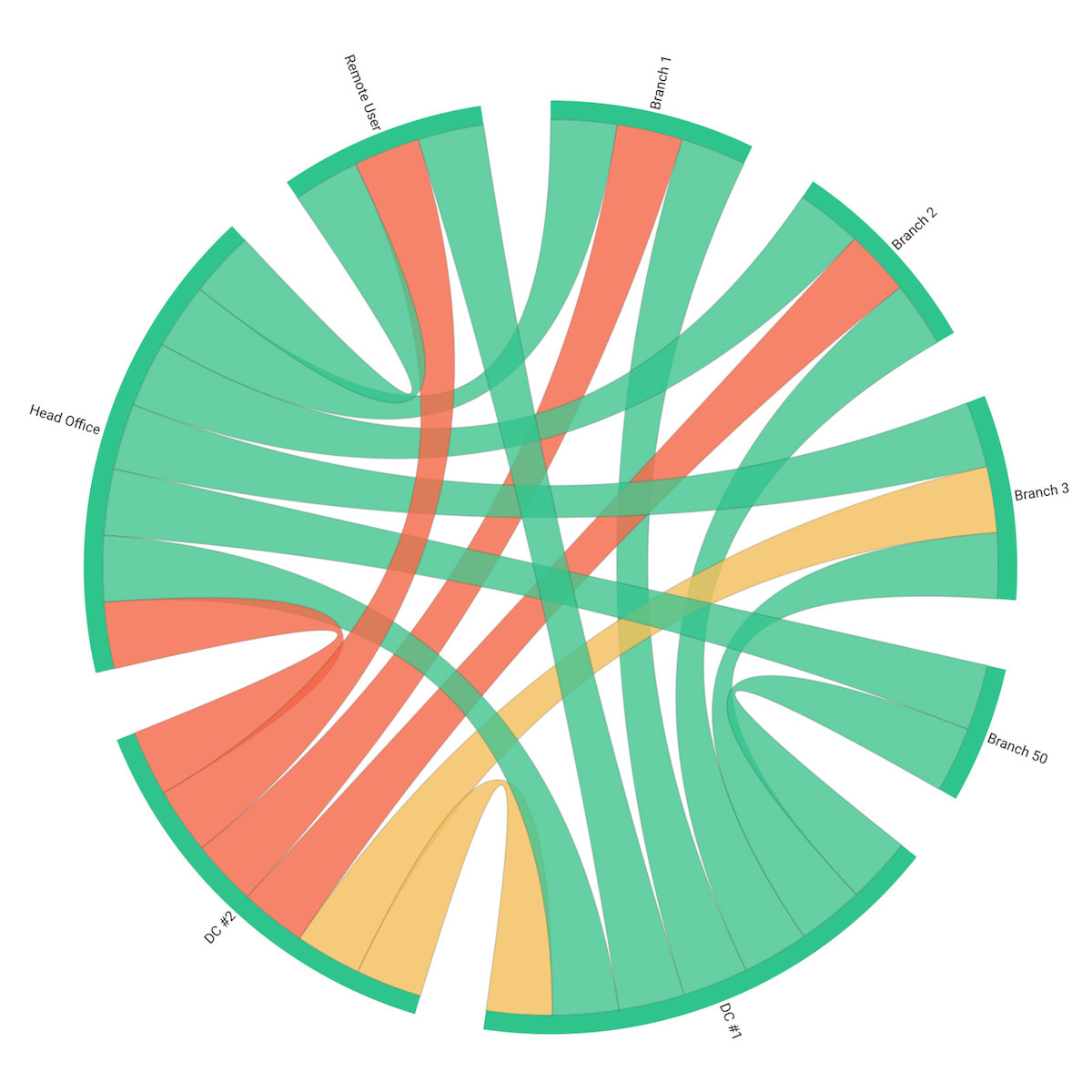
Once you’ve deployed Obkio Monitoring Agents in your key network locations, they will start measuring key network metrics related to network connectivity issues, such as:
- Latency: Latency measures the time it takes for data to travel from one point in the network to another. High latency can cause network connectivity issues and slow down network speeds.
- Bandwidth: Bandwidth measures the amount of data that can be transmitted over the network in a given time period. Insufficient bandwidth can cause network congestion or network overload and slow down network speeds.
- Packet Loss: Packet loss occurs when data packets are lost during transmission. This can be caused by network congestion, hardware issues, or software issues.
- Jitter: Jitter measures the variation in latency over time. High jitter can cause problems with real-time applications, such as video conferencing. This is especially true for VoIP jitter.
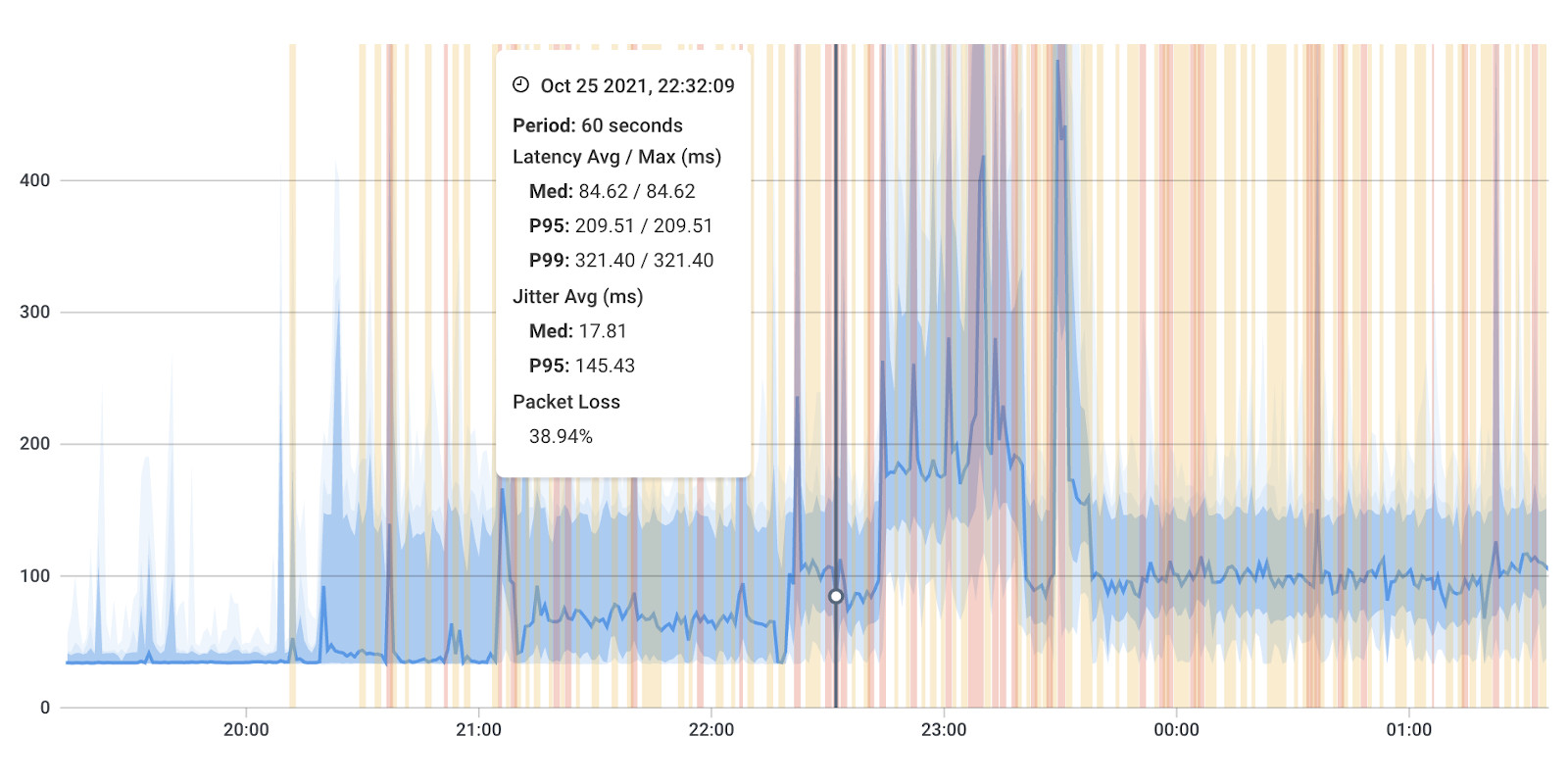
Measuring these key network metrics will allow you to better understand if your network is really experiencing performance or connectivity issues. To identify network issues, you’ll want to let the Agents run and collect data for some time. If your issues are really bad, you’ll see the performance issues after just a few minutes, but we recommend letting the Agents collect data for at least 3 hours.
To begin troubleshooting the network connectivity issue, you need to catch it first. This means that you need to identify where exactly the issue is happening in your network, and if it’s a network issue at all.
To do this, compare the monitoring sessions between the two Public Monitoring Agents you deployed.
As a reference, below is an example of a Network Session with no network performance or connectivity issues.
If it’s not a network issue, it might be a user issue. In this case, you can install a Monitoring Agent directly on a user’s workstation (the user who is experiencing the performance problems) to see the issue from their point of view.
If you still don’t find that it’s a network issue at this point, it may just be a problem that IT specialists can solve directly on the user's workstation or on the remote destination. The problem could be several other hardware-intensive videoconferencing systems, which use up a lot of resources (CPU, RAM).
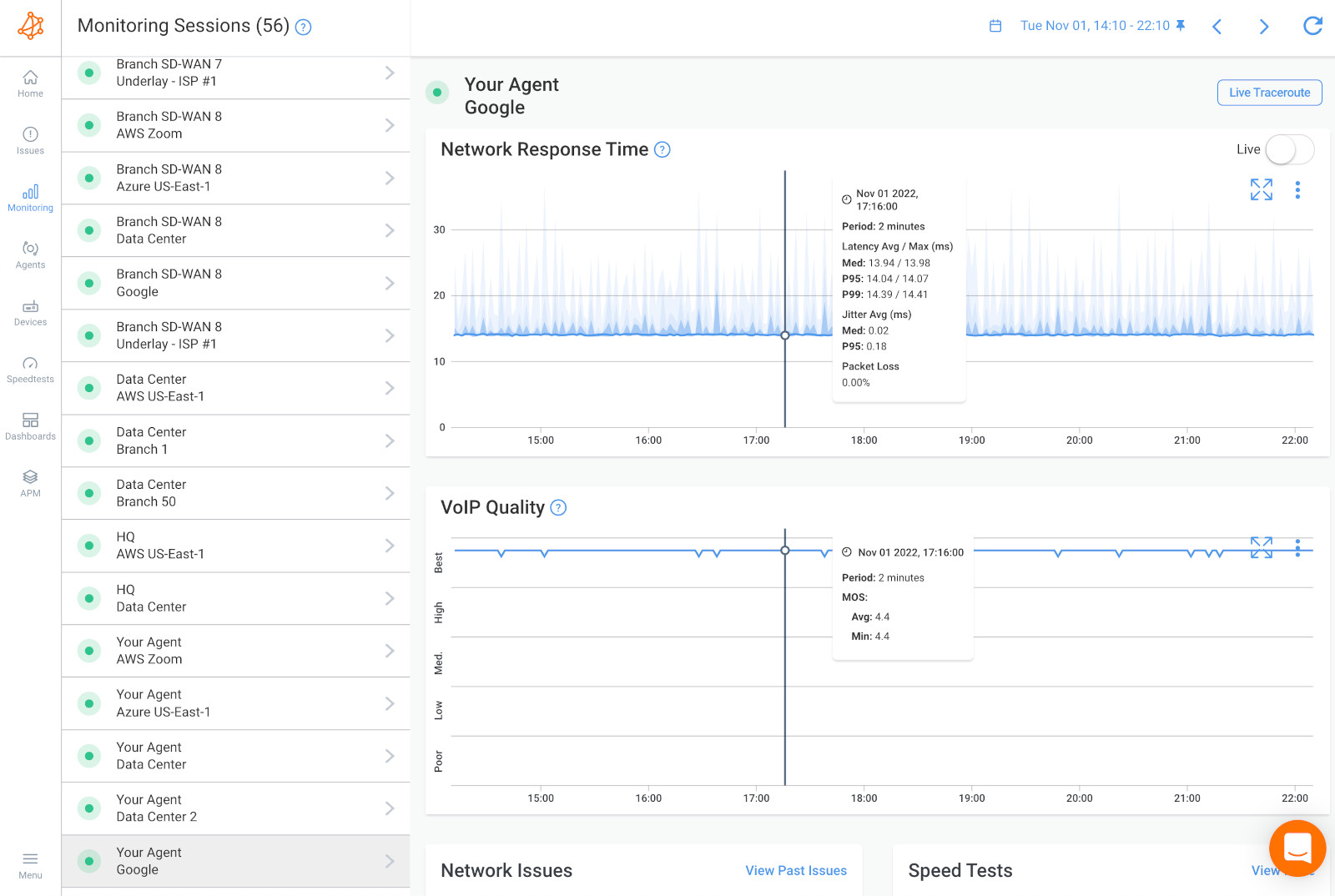
The screenshot below is an example of a network connectivity issue happening on both of your network sessions.
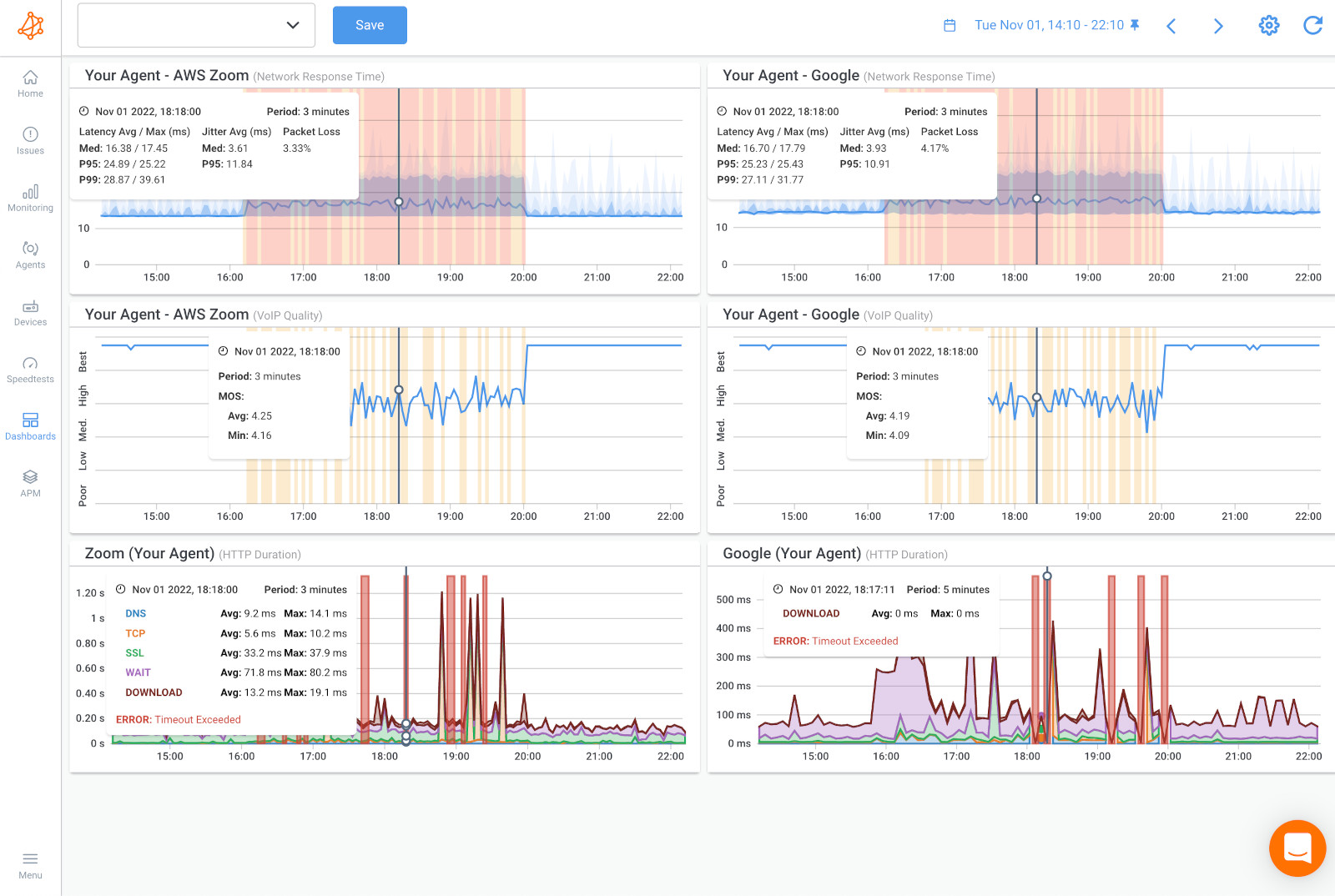
When this happens, it means that the network issue is happening on a network segment that is common to both network sessions. This means that the problem is:
- Broader and not exclusive to a single network path or destination.
- Affects all services and applications dependent on the network.
- Could be happening in LAN, the firewall or the local loop Internet connection.
The screenshot below is an example of a network connectivity issue happening on only one of your network sessions.
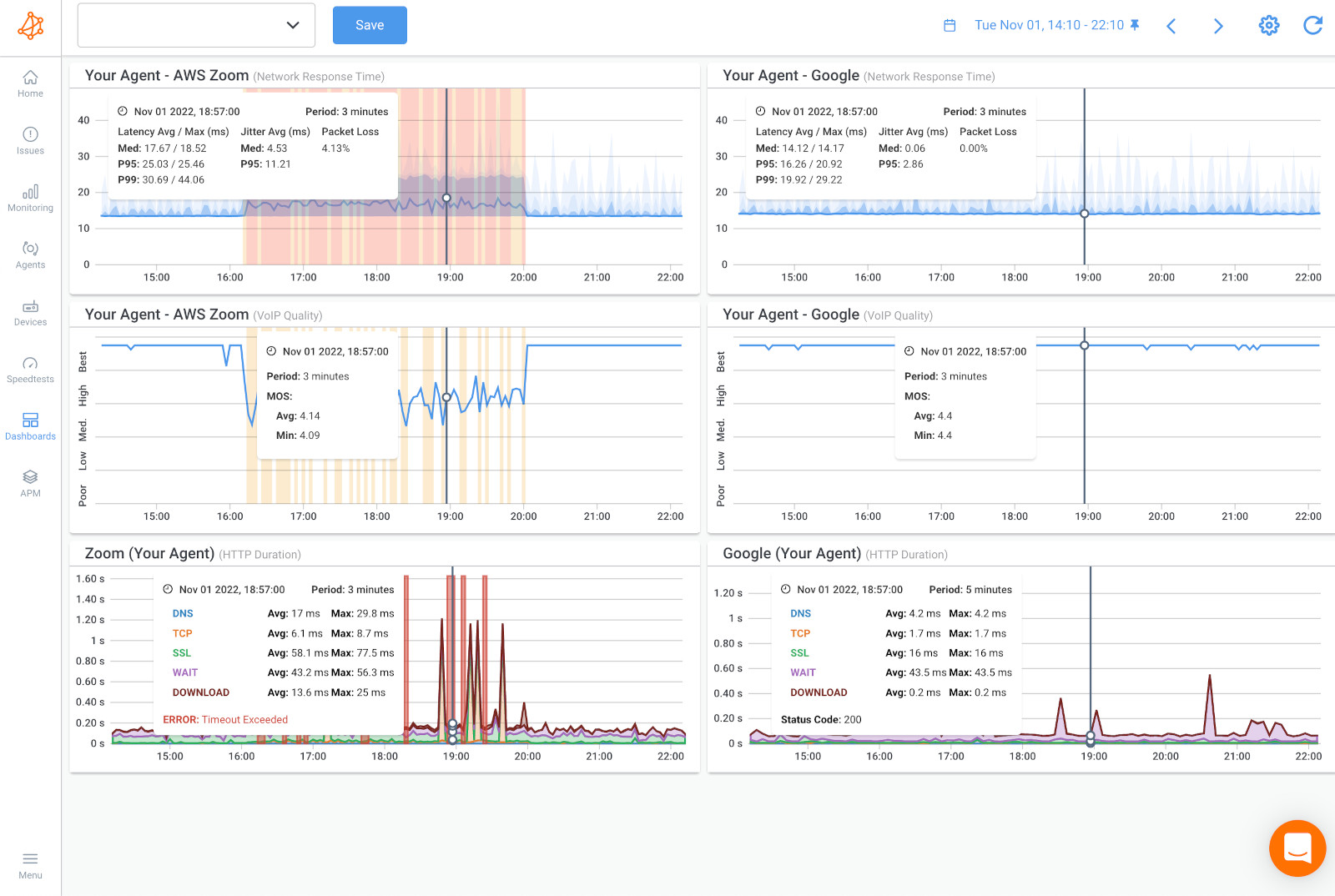
This means that the network issue is happening only towards that specific location on the Internet and that the problem is further away.
If a network connectivity issue is happening on both network sessions, compare that data using Obkio’s Device Monitoring feature to further understand if the network issue is happening on your end, or over the Internet, in your Service Provider’s network.
With Obkio’s Device Monitoring, monitor the performance of devices like routers, switches, firewalls and more, to measure resource metrics that can affect and cause network connectivity issues such as:
- CPU and memory usage: High CPU usage or memory usage can indicate that a device is overburdened and may be causing network connectivity issues.
- Interface errors: Interface errors occur when there are errors in the transmission of data on a network interface. This could be caused by hardware issues or configuration problems.
- Power supply status: Power supply issues can cause network devices to malfunction and result in network connectivity issues.
- Temperature: Overheating can cause network devices to malfunction and result in network connectivity issues.
- Firmware and software versions: Outdated firmware or software can cause compatibility issues and result in network connectivity issues.
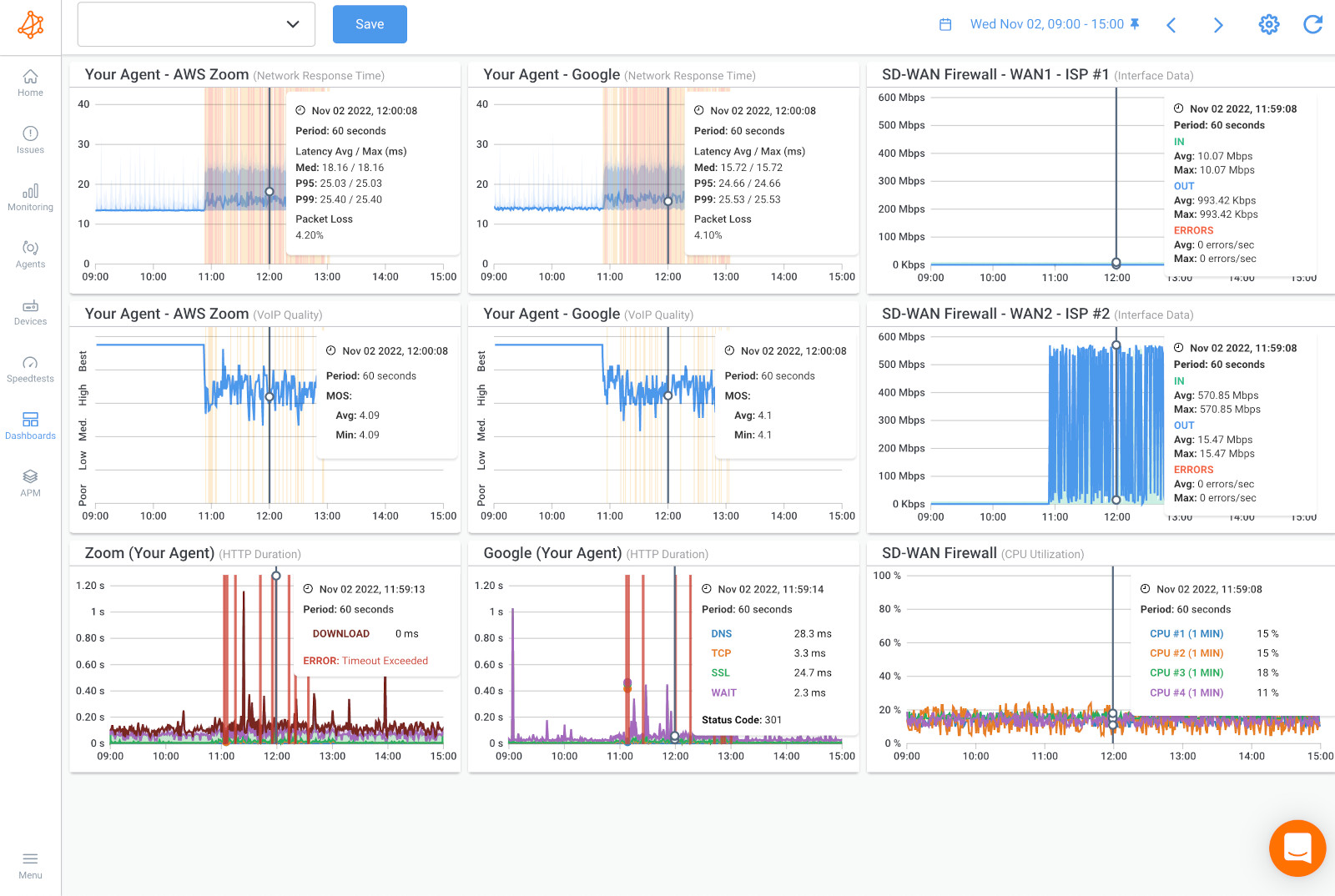
By monitoring these device-level metrics, you can identify potential problems and take steps to address them. This may involve replacing hardware, updating firmware and software, or adjusting configuration settings.
When you compare your previous data with Device Monitoring metrics, you may find CPU, Bandwidth or other resource issues. These resource issues likely mean that the network issue is on your end and you need to troubleshoot internally.
Some of the most common resource issues include
- Insufficient bandwidth: If your network does not have enough bandwidth to handle the amount of traffic being transmitted, this can cause network connectivity issues.
- Overutilized CPU and memory: When network devices such as routers and switches are overutilized, this can result in network connectivity issues. This is because these devices may not be able to process incoming traffic fast enough.
- Power supply problems: If a network device's power supply is faulty, this can cause the device to malfunction and result in network connectivity issues.
- Overheating: Network devices generate heat, and if they become too hot, they may malfunction and cause network connectivity issues.
- Network congestion: When too much traffic is transmitted over a network, this can cause network congestion, resulting in network connectivity issues.
If you don’t see any resource issues from your devices, this is a sign that the network connectivity issue is actually on your Service Provider’s end.
In this case, you need to open a service ticket with all the information you can collect to prove that the issue is on the ISP’s end, and get quickly escalated past 1st level support.
To do this, we’ll be using Obkio Vision, Obkio’s free Visual Traceroute tool that runs continuously to interpret Traceroute results to identify network problems in your WAN and over the Internet.

Using Traceroutes, the Network Map, and the Quality Matrix you’ll be able to identify if:
- The network issue is happening specifically towards a specific location over the Internet. So only one specific site is being affected.
- The network issue is on your ISP’s side and you need to open a service ticket with as much information as you can collect.
Feeling trapped in a web of network connectivity issues? After following the steps above, you’ll now know what the network connectivity issue is, and if it’s happening internally or externally. If the problem is internal, it’s up to your network or IT team to troubleshoot.
The next steps you take will depend on the type of issue and its cause, but here are some basic steps you can take depending on the network connectivity issue at hand:
By verifying physical connectivity, you can rule out any potential physical issues that may be causing network connectivity issues. If physical connectivity is not the issue, it may be necessary to move on to other steps to troubleshoot networks.
Here are some specific things you can do to verify physical connectivity:
- Check the cables: Ensure that all cables are properly connected and not damaged. If a cable is damaged, replace it with a new one.
- Check the power: Verify that the device is receiving power. If it is not, check that the power cord is plugged in and that the outlet is working.
- Check the network interface: Ensure that the network interface on the device is enabled and functioning properly.
- Check the lights: Check the lights on the device to see if they are indicating any errors or connectivity issues. Different devices may have different light indicators, so consult the device documentation for specific information.
- Check for physical damage: Check the device for any physical damage that may be causing connectivity issues, such as a damaged port or antenna
Another step is ensuring that the network configuration is correct and that all devices have the correct IP address and subnet mask. By checking network configuration, you can identify potential misconfigurations or errors that may be causing network connectivity issues. Once identified, you can correct the configurations to resolve the issues.
- Check IP addresses: Verify that devices on the network have unique IP addresses and that they are on the correct subnet. You can use tools like ipconfig (Windows) or ifconfig (Linux) to check IP addresses.
- Check DNS settings: Ensure that DNS settings are configured correctly on all devices. This includes verifying that DNS servers are reachable and that devices are configured to use the correct DNS servers.
- Check routing tables: Verify that routing tables are correctly configured on devices that use routing protocols. This includes ensuring that default gateways are configured correctly and that routes are being advertised and received correctly.
- Check firewall settings: Ensure that firewall settings are correctly configured on devices that have firewalls. This includes verifying that ports are open for necessary services and that rules are correctly configured.
- Check network services: Verify that network services, such as DHCP and NTP, are correctly configured and functioning properly.
Pinging the device is a basic troubleshooting step that can help you determine if the device is reachable and responding to network requests. If it is not responding, this could indicate a connectivity issue.
Here are the steps to ping a device:
- Open a command prompt: On Windows, open the Command Prompt. On macOS or Linux, open the Terminal.
- Enter the ping command: Type "ping" followed by the IP address or hostname of the device you want to ping. For example, if you want to ping a device with the IP address 192.168.1.1, type "ping 192.168.1.1" and press Enter.
- Interpret the results: If the device responds to the ping request, you should see a series of responses indicating the network round-trip time and other statistics. If the device does not respond, you may see "Request timed out" or "Destination host unreachable" messages.
Pinging a device can help you determine if the device is reachable and responding to network requests. If the device does not respond to pings, it may indicate that there is a network connectivity issue between your device and the target device. You can then use the results of the ping test to further troubleshoot the issue.
Next, Ensure that the network adapter settings are correct and that the correct driver is installed. By checking the network adapter settings, you can ensure that your network adapter is properly configured and connected to the network. If there are any issues with the adapter settings, you can then troubleshoot and fix them accordingly.
- Open Network and Sharing Center: On Windows, go to Control Panel > Network and Sharing Center. On macOS, go to System Preferences > Network.
- Check the adapter status: Check if the network adapter is enabled and connected. If it's not, you may need to enable it or connect it to a network.
- Check the IP configuration: Check the IP address configuration of the network adapter. Make sure it has a valid IP address, subnet mask, default gateway, and DNS server address. If the IP configuration is incorrect, you may need to reconfigure it manually or use DHCP to obtain an IP address automatically.
- Check for duplicate IP addresses: If multiple devices have the same IP address, it can cause network connectivity issues. Make sure the IP address of your network adapter is unique.
- Check for proxy settings: If your network uses a proxy server, make sure your network adapter is configured to use the correct proxy settings.
Verify that all required network services are running, such as DHCP and DNS. By checking network services, you can ensure that all the required services are running and configured correctly. If there are any issues with the network services, you can troubleshoot and fix them accordingly, which can help to resolve network connectivity issues.
- Check if required network services are running: Network services such as DHCP, DNS, and firewall services (managed by MSSPs) are essential for network connectivity. Check if these services are running on the appropriate servers or devices.
- Restart network services: If a network service is not running, try restarting it. This can help to resolve the issue in some cases.
- Check for conflicts between network services: If there are conflicts between network services, it can cause network connectivity issues. For example, a firewall may be blocking traffic from a required network service. Check for conflicts and resolve them as needed.
- Check for software or firmware updates: Sometimes, network connectivity issues can be caused by outdated software or firmware. Check if there are any updates available for your network devices and services, and apply them if needed.
Verify that the firewall is not blocking traffic and that security settings are configured correctly. By checking firewall and security settings, you can ensure that they are not causing any network connectivity issues. If there are any issues with the firewall or security settings, you can troubleshoot and fix them accordingly, which can help to resolve network connectivity issues.
- Check firewall rules: Firewalls can block incoming or outgoing traffic that is required for network connectivity. Check firewall rules to ensure that the appropriate ports and protocols are allowed through the firewall.
- Disable firewalls: Temporarily disabling firewalls can help to troubleshoot network connectivity issues. If disabling the firewall resolves the issue, you can add an exception rule to the firewall instead of keeping it disabled.
- Check security settings: Security settings such as antivirus and anti-malware software can sometimes block network traffic that is required for connectivity. Check security settings to ensure that they are not blocking any required network traffic.
- Update firewall and security software: Outdated firewall and security software can cause network connectivity issues. Check for updates and apply them if needed.
Verify that the device's firmware is up to date and that any known issues have been resolved. Firmware updates can sometimes resolve network connectivity issues, especially if the issue is related to a particular network device.
Here are some steps to check for firmware updates:
- Identify the device: Identify the network device that is experiencing the connectivity issue. This could be a router, switch, or another network device.
- Check the manufacturer's website: Visit the manufacturer's website to find out if there are any available firmware updates for the device.
- Download and install the firmware update: If there is a firmware update available, download it from the manufacturer's website and install it on the device according to the manufacturer's instructions.
- Restart the device: After the firmware update is installed, restart the device to apply the changes.
By checking for firmware updates, you can ensure that your network devices are up-to-date and operating at their best capacity, which can help to resolve network connectivity issues. If there are no firmware updates available or if the firmware update does not resolve the connectivity issue, you can continue to troubleshoot using other steps.
Using network diagnostic tools can be helpful in troubleshooting network connectivity issues. There are a variety of network diagnostic tools available, and the specific tool you use will depend on the issue you are experiencing.
Some common network diagnostic tools include:
- Network analyzer: This tool captures and analyzes network traffic in real-time, allowing you to identify network issues and monitor network performance.
- Netstat: This tool displays active network connections, as well as the status of network ports and protocols.
- Obkio: A Network Performance Monitoring that can help you troubleshoot network connectivity issues. provides end-to-end visibility into network performance, allowing you to proactively identify and resolve network issues before they impact users. With Obkio, you can monitor network traffic in real-time, track network latency and packet loss, and identify network issues through detailed analytics and alerts.
Ping is a command-line tool that is commonly used to test network connectivity. It sends a small packet of data to a network device or a website and waits for a response. If the device or website responds, then it is a sign that the network is functioning properly. If there is no response, then there may be an issue with the network.
Ping is a simple yet effective tool for troubleshooting network connectivity issues. It can help you identify issues with network latency, packet loss, and routing problems. The command can be used to test the connectivity of various devices such as servers, routers, and switches.
To use Ping, you need to open a command prompt or terminal window and type in "ping" followed by the IP address or domain name of the device or website you want to test. For example, to test the connectivity of google.com, you would type "ping google.com" and hit enter.
Ping also allows you to specify the number of packets you want to send, the size of the packets, and the time interval between the packets. This can be useful for troubleshooting specific issues on the network.
Overall, Ping is a powerful and versatile tool that can be used to troubleshoot a wide range of network connectivity issues.
Traceroute is another useful network diagnostic tool that can help you identify connectivity issues on a network. Traceroute works by sending packets from your device to the destination device and recording the time it takes for each packet to reach its destination. This information is then used to build a list of all the routers that the packet travelled through on its journey.
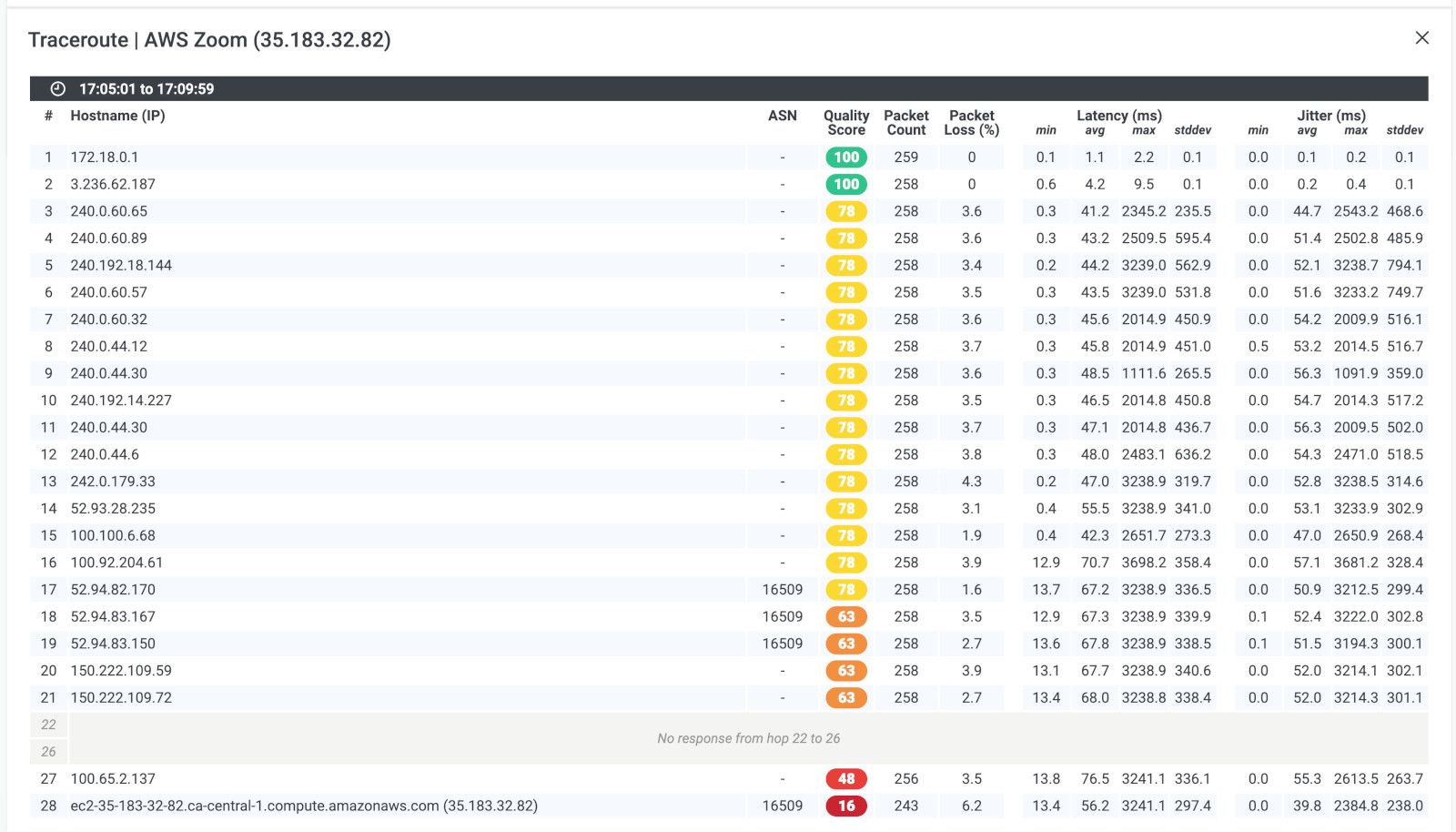
Traceroute can be particularly useful when you're troubleshooting network connectivity issues that are caused by routing problems. For example, if a packet is taking a long time to reach its destination, Traceroute can help you identify which routers are causing the delay. You can then use this information to pinpoint the problem and work on resolving it.
To use Traceroute, you'll need to open a command prompt on your device and type "traceroute [destination IP address or hostname]". This will start the Traceroute process and generate a list of all the routers that the packet travels through on its journey. You can then use this information to identify any routing issues that may be causing network connectivity problems.
However, it's worth noting that Traceroute may not always provide accurate results, particularly if network traffic is being filtered or blocked by a firewall or other security measures. In these cases, you may need to use other network diagnostic tools to identify the source of the problem.
Your router is the heart of your network, responsible for managing all incoming and outgoing traffic. If you're experiencing network connectivity issues, it's possible that your router's settings may be the culprit. In this section, we'll take a look at some common router settings that may need to be adjusted to resolve network issues. Keep in mind that changing router settings can be complex and may require some technical expertise, so proceed with caution!
Here are some ways you can configure your router settings to troubleshoot network connectivity issues:
- Update firmware: Make sure your router firmware is up to date. Manufacturers often release firmware updates that address security issues and improve performance.
- Reset router: If you're experiencing network connectivity issues, try resetting your router. This will often resolve issues related to configuration or software.
- Check network settings: Ensure that your router's network settings are configured properly. This includes settings such as DHCP, NAT, and port forwarding.
- Enable Quality of Service (QoS): QoS allows you to prioritize traffic on your network. If you're experiencing slow network speeds, enabling QoS can help improve performance for critical applications. For example, implementing QoS for VoIP.
- Check wireless settings: If you're experiencing WiFi connectivity issues, check your router's wireless settings. Ensure that your SSID is unique and not using default settings and that your security settings are properly configured.
- Change channel: If you're experiencing interference from other wireless networks, try changing the channel your router is using. This can help improve network performance.
- Enable guest network: If you're experiencing issues with network performance due to multiple devices, consider enabling a guest network. This can help reduce congestion on your primary network.
By following these tips, you can configure your router to help troubleshoot network connectivity issues and improve network performance.

Wireless networks can be a lifesaver, allowing us to connect to the Internet virtually anywhere. But sometimes, WiFi connectivity issues can be a real nightmare. Slow speeds, weak signal, interference – these can all make it difficult to stay connected.
When we talk about network connectivity issues, we can’t forget that they can happen in all parts of the network, including over the Internet and Wi-Fi connections.
In this section, we'll dive into some common WiFi connectivity issues and how to troubleshoot them.
- Signal strength: If the Wi-Fi signal is weak, you may experience slow or dropped connections. Check the signal strength by moving closer to the wireless access point (WAP) or router. If possible, consider moving the WAP or router to a more central location in the building.
- Interference: Other wireless devices or appliances can interfere with the Wi-Fi signal, causing connectivity issues. Try moving the WAP or router away from other wireless devices or appliances, such as microwaves or cordless phones.
- Channel congestion: Wi-Fi networks operate on specific channels, and if too many networks are using the same channel, it can cause connectivity issues. Use a Wi-Fi analyzer tool to identify which channels are being used and switch to a less congested channel.
- Security settings: Ensure that your Wi-Fi network is secure with a strong password to prevent unauthorized access. Weak passwords or no passwords at all can cause connectivity issues.
- Driver issues: Outdated or corrupted Wi-Fi drivers can cause connectivity issues. Update the drivers for the Wi-Fi adapter in your device or consider using a USB Wi-Fi adapter as an alternative.
- Router issues: Resetting the router to its factory settings can sometimes resolve connectivity issues. Consult the router's manual or manufacturer's website for instructions on how to reset the router.
By addressing these common causes of Wi-Fi connectivity issues, you can help ensure that your wireless network is operating smoothly and providing reliable connectivity. Another more advanced technique to troubleshoot network connectivity issues related to your Wi-Fi can also include:
Sometimes, WiFi connectivity issues can be caused by problems with DNS (Domain Name System) servers. DNS servers are responsible for translating web addresses (URLs) into IP addresses that your computer can understand. If your computer can't connect to the DNS server, or if the server is slow or unresponsive, this can result in slow or intermittent internet connectivity.
One way to troubleshoot DNS-related WiFi issues is to change your DNS server settings. By default, your computer and router are set to use your Internet Service Provider's (ISP) DNS servers. However, you can try changing these settings to use a third-party DNS service like Google Public DNS or OpenDNS.
To change your DNS settings on a Windows computer, follow these steps:
- Click on the Start menu and type "Network and Sharing Center" in the search box. Click on the "Network and Sharing Center" option that appears.
- Click on "Change adapter settings" in the left-hand menu.
- Right-click on your WiFi connection and select "Properties" from the context menu.
- Scroll down to the "Internet Protocol Version 4 (TCP/IPv4)" option and click on it to select it.
- Click on the "Properties" button.
- In the "General" tab, select "Use the following DNS server addresses" and enter the IP addresses for the DNS servers you want to use. For example, Google Public DNS uses the IP addresses 8.8.8.8 and 8.8.4.4.
- Click "OK" to save your changes.
Changing your DNS server settings can help improve your WiFi connectivity by providing a more reliable and faster DNS service. However, it's important to note that changing your DNS settings may also impact your internet speed and overall network performance, so it's a good idea to test different DNS services to find the one that works best for you.
Troubleshooting network connectivity issues can sometimes be complex, but following best practices can help you identify and resolve problems efficiently. Whether you're dealing with a single device unable to access the internet or a larger network-wide disruption, these best practices will empower you to identify, diagnose, and resolve connectivity issues effectively.
1. Identify the Scope of the Issue:
- Determine if the connectivity issue is affecting a single device or multiple devices.
- Check if the issue is limited to a specific application, service, or website.
2. Check Physical Connections:
- Ensure all cables are securely connected and not damaged.
- Verify that devices like routers, switches, and access points are powered on and functioning properly.
3. Restart Devices:
- Reboot the affected device(s), including routers, modems, switches, and computers. Sometimes, a simple restart can resolve connectivity problems.
4. Check Network Indicators:
- Look for LED lights on network devices to identify any connectivity issues. Different colors or patterns can indicate problems.
5. Test Other Devices:
- Check if other devices are able to connect to the network. If only one device is affected, the issue may be specific to that device.
6. Ping and Traceroute:
- Use the command prompt or terminal to ping other devices or websites. This can help determine if there's a communication problem between your device and the destination.
- Run a traceroute to identify the route taken by data packets and pinpoint where the connection is failing.
7. Check IP Configurations:
- Verify that devices have valid IP addresses, subnet masks, and default gateways configured.
- Ensure that DHCP (Dynamic Host Configuration Protocol) is working correctly if your network uses it to assign IP addresses.
8. Firewall and Security Software:
- Temporarily disable firewall or security software to check if they are causing the connectivity issue.
- Make sure the firewall rules are not blocking necessary network traffic.
9. Update Firmware and Drivers:
- Ensure that network devices, such as routers and network interface cards, have the latest firmware and drivers installed.
10. Check DNS Settings:
- Ensure that DNS (Domain Name System) settings are configured correctly. Incorrect DNS settings can lead to issues accessing websites.
11. Use Different Browsers or Applications:
- If the issue is related to a specific website or application, try accessing it using a different browser or app to rule out software-related problems.
12. Test Different Networks:
- If possible, test the device on a different network (e.g., a mobile hotspot) to see if the problem persists.
13. Contact ISP:
- If the issue is related to internet connectivity, contact your Internet Service Provider (ISP) to check for outages or problems on their end.
14. Document Findings:
- Keep a record of the steps you've taken and the results of each test. This information can be useful when seeking help from others or when diagnosing persistent issues.
15. Seek Professional Help:
- If you've exhausted your troubleshooting options and the issue persists, consider reaching out to a professional network technician or IT support for assistance.
Remember that network connectivity issues can have various causes, ranging from simple configuration problems to more complex hardware or infrastructure issues. Patiently following these network monitoring best practices can often lead you to the root cause of the problem and help you resolve it effectively.
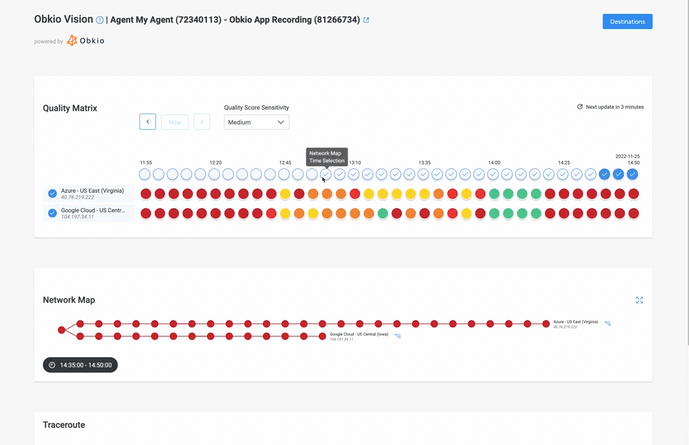
Congratulations, you've made it to the end of our Great Network Escape! Now that you've learned how to troubleshoot network connectivity issues like a pro, it's time to ensure they never bother you again. In this section, we'll give you tips and tricks on how to stay connected and prevent future network headaches. Let's dive in!
In this section, we'll discuss some tips for preventing network connectivity issues from happening in the first place. By taking proactive measures, you can ensure that your network stays up and running smoothly, with minimal downtime, disruptions or network disconnections. Here are some key strategies to keep in mind:
- Regularly update your firmware: Keep your network devices up to date with the latest firmware updates to avoid potential bugs or security vulnerabilities.
- Implement security measures: Configure firewalls, VPNs, and other security tools to protect your network from threats.
- Monitor your network performance: Use network monitoring tools, such as Obkio Network Performance Monitoring, for network connectivity monitoring, to keep tabs on your network's performance and identify any potential issues before they become major problems.
- Educate your users: Teach your employees or users best practices for using your network, such as avoiding downloading suspicious files or using unsecured public Wi-Fi networks.
By following these tips, you can help ensure that your network stays connected and functioning at optimal levels, allowing you to focus on your work or enjoy uninterrupted internet browsing.


You may have successfully escaped the clutches of network connectivity issues, but don't get too comfortable just yet. In this section, we'll share some best practices for keeping your network healthy and happy so you can avoid another daring escape in the future.
Here are some best practices for maintaining a healthy network and preventing network connectivity issues:
- Regularly update network devices: Firmware updates can improve device performance, security, and stability. Make sure to check for firmware updates and install them regularly.
- Implement security measures: Firewalls, antivirus software, and other security measures can help prevent network security breaches and protect your devices from malware and other threats.
- Monitor network traffic: Keep an eye on your network traffic to identify potential issues before they become major problems. Use network monitoring tools to track network performance and detect abnormal traffic patterns.
- Use quality network hardware: Invest in quality network hardware such as routers, switches, and cables to ensure that your network is reliable and performs well.
- Implement network redundancy: Set up redundant network paths and devices to ensure that your network remains functional even in the event of hardware failure or other issues.
By following these best practices, you can help maintain a healthy network and prevent network connectivity issues from occurring.
Being a network troubleshooter requires the persistence of a toddler asking 'why?' over and over again, the foresight of a fortune-teller, and the proactive mindset of a squirrel gathering nuts for the winter. Don't fret, with these best practices for maintaining a healthy network, you'll be able to prevent connectivity issues before they even occur! Let's dive in.
When it comes to network connectivity issues, persistence is key. Here are some best practices to help you stay on top of any potential problems:
- Continuous monitoring: By continuously monitoring your network, you can quickly identify any issues that may arise and address them before they cause major problems. This can be done through the use of network performance monitoring tools or network testing tools, such as Obkio, which can provide you with real-time data on your network's performance.
- Proactive troubleshooting: Rather than waiting for problems to occur, be proactive in troubleshooting your network. This means regularly checking for firmware updates, reviewing logs and network monitoring alerts, and conducting regular network assessments to identify potential vulnerabilities.
- Maintain a healthy network: Implement best practices for maintaining a healthy network, such as configuring your router properly, regularly updating your antivirus software, and regularly changing your passwords.
Remember, persistence is key to ensuring that your network remains healthy and running smoothly. By continuously monitoring and proactively troubleshooting your network, you can catch problems early and prevent them from becoming major issues.

Whether you're an IT pro or a networking novice, troubleshooting network connectivity issues can be a frustrating challenge. But armed with the right tools and techniques, you can escape the network slowdowns and connection issues that keep you from your online destiny.
Remember to stay persistent, keep monitoring your network, and proactively troubleshoot issues before they become major headaches. With these tips and Obkio’s Network Monitoring tool in your toolbelt, you'll be the hero of your network's great escape!


























 Obkio Blog
Obkio Blog







